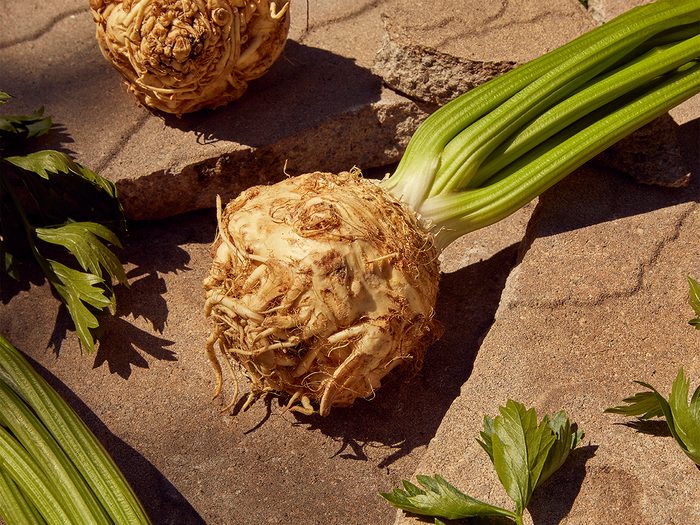Celeriac May Just Be Our New Favourite Vegetable for Fall Dishes

Celeriac is that knobby, rustic-looking root vegetable you’ve probably passed over at the grocery store. Or perhaps it recently turned up in your produce box and you were at a loss for what to do with it. Although it may not be the prettiest vegetable on the shelf, celeriac is truly an underrated, nutrient-dense root—don’t overlook its cooking and health potential.
Celeriac (also known as celery root or turnip-tipped celery) is a cousin of celery, but it’s grown for its gnarly, bulbous root instead of for its stalks. Botanically, celeriac is closely related to celery, but they are not interchangeable in cooking. Celeriac has a rough, light brown exterior while the interior flesh is firm and creamy white and has a parsnip-like texture. While celeriac looks nothing like celery, it maintains a bold celery flavour that is also faintly nutty with hints of fennel and parsley. Celeriac is widely available year-round, but is at its best between September and April.
Apart from being tasty, celeriac is a good source of fibre and vitamins B6, C and K. One cup of celeriac has around 75 percent of your daily recommended intake of vitamin K, a fat-soluble vitamin with a range of health benefits. It also contains about a third of the carbohydrates as potatoes per portion.
Vitamin K is the umbrella term for a family of compounds: There are two main types, vitamin K1 and vitamin K2. The main source of K1 are vegetables, especially dark leafy greens, while K2 is found in fermented foods like yogurt and is also manufactured by lactic acid-producing bacteria in the gut. Vitamin K1 is principally transported to the liver, where it regulates the production of blood-clotting proteins. Vitamin K2 moves to tissues such as artery walls, where it goes on to make other vitamin K-dependent proteins that work closely with vitamin D, another fat-soluble vitamin, in calcium metabolism and to support vascular health. The protein that K2 produces in your bones, osteocalcin, promotes bone mineralization, which improves bone density and strength, two things that typically decrease with age, especially post-menopause. In vascular muscles, which make up the walls of blood vessels, vitamin K2 produces matrix Gla-proteins, which prevent the calcification and hardening of arteries, helping to reduce risk of heart disease.
While vitamin K deficiencies are uncommon, eating vitamin K-rich foods will maximize vitamin D’s health benefits, like building bone strength, maintaining muscle and nerve function and boosting immunity. Seek out vitamin K-heavy veggies like kale, broccoli, cabbage and celeriac, and look for a vitamin D supplement that contains vitamin K2 to optimize the health benefits.
When picking a celeriac at the grocery store, seek out roots that are firm, unblemished and heavy for their size. Avoid roots with a greenish blush. They have been sitting out for longer and are less fresh. For easiest prep, lob off the bottom and top so that it sits flat on your cutting board, then remove the outer peel using a knife. Once cut, celeriac discolours easily, so store in a bowl of water with lemon juice or vinegar to prevent browning. To maximize freshness, store unpeeled celeriac in a sealed plastic bag in the fridge for up to three weeks, or peel, cut into chunks and freeze.
Celeriac pairs well with other fall flavours like apple, fennel and sage. Like other root vegetables, it’s wonderful when roasted, which brings out its natural sweetness. Mix cooked celeriac with other starchy vegetables, like potatoes, to create a lower-in-carbs mash to serve alongside sausages and top cottage pie, or blend into a pureed soup—it will add a silky texture without the need for dairy.
To maintain celeriac’s crunch, try it out in raw dishes like a slaw or salad. Cut peeled celeriac into thin matchsticks, then use it to create celeriac remoulade, a creamy, mustard-y slaw popular in France. For a crunchy, refreshing and unexpected fall salad, shave off into wider strips using a vegetable peeler and toss with apple and fennel.
Next time you hit the grocery store, seek out celeriac, the unsung hero of the root vegetable world, because sometimes ugly is also next-level delicious.
Laura Jeha is a registered dietitian, nutrition counsellor and recipe developer. Find out more at ahealthyappetite.ca.
Next: A Recipe for Celeriac Gnocchi with Brown Butter and Sage




